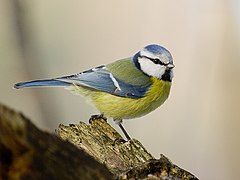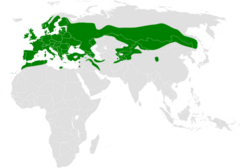Cyanistes
| Cyanistes | |||
| Kaup, 1829[1] | |||
 Przedstawiciel rodzaju – modraszka zwyczajna (C. caeruleus) | |||
| Systematyka | |||
| Domena | |||
|---|---|---|---|
| Królestwo | |||
| Typ | |||
| Podtyp | |||
| Gromada | |||
| Podgromada | |||
| Infragromada | |||
| Rząd | |||
| Podrząd | |||
| Rodzina | |||
| Rodzaj |
Cyanistes | ||
| Typ nomenklatoryczny | |||
|
Parus cyanus Pallas, 1770 | |||
| Synonimy | |||
|
| |||
| Gatunki | |||
| |||
| Zasięg występowania | |||

| |||
Cyanistes – rodzaj ptaków z rodziny sikor (Paridae).
Zasięg występowania
[edytuj | edytuj kod]Rodzaj obejmuje gatunki występujące w Eurazji i północnej Afryce[4].
Morfologia
[edytuj | edytuj kod]Długość ciała 11–14 cm; masa ciała 7,5–16 g[5].
Systematyka
[edytuj | edytuj kod]Rodzaj zdefiniował w 1829 roku niemiecki paleontolog i przyrodnik Johann Jakob Kaup w publikacji swojego autorstwa o tytule Skizzirte Entwickelungs-Geschichte und natürliches System der europäischen Thierwelt[1]. Kaup nie wskazał gatunku typowego; w ramach późniejszego oznaczenia w 1842 roku brytyjski ornitolog George Robert Gray na typ nomenklatoryczny wyznaczył sikorę lazurową (C. cyanus)[6].
Etymologia
[edytuj | edytuj kod]Cyanistes (Cyanites, Cyanetes): gr. κυανιζω kuanizō „być ciemnoniebieskiego koloru”[7].
Podział systematyczny
[edytuj | edytuj kod]Do rodzaju należą następujące gatunki[8]:
- Cyanistes caeruleus (Linnaeus, 1758) – modraszka zwyczajna
- Cyanistes teneriffae (Lesson, 1831) – modraszka kanaryjska
- Cyanistes cyanus (Pallas, 1770) – sikora lazurowa
Uwagi
[edytuj | edytuj kod]Przypisy
[edytuj | edytuj kod]- ↑ a b J.J. Kaup: Skizzirte Entwickelungs-Geschichte und natürliches System der europäischen Thierwelt: Erster Theil welcher die Vogelsäugethiere und Vögel nebst Andeutung der Entstehung der letzteren aus Amphibien enthält. Darmstadt: In commission bei Carl Wilhelm Leske, 1829, s. 99. (niem.).
- ↑ Ch.-L. Bonaparte. Notes sur les collections rapportées en 1853, par M.A. Delattre, de son voyage en Californie et dans le Nicaragua. „Comptes Rendus Hebdomadaires des Séances de l’Académie des Sciences”. 38, s. 63, 1854. (fr.).
- ↑ L. Olphe-Galliard: Contributions à la faune ornithologique de l’Europe occidentale: recueil comprenant les espèces d’oiseaux que se reproduisent dans cette région ou qui s’y montrent régulièrement de passage, augmenté de la description des principales espèces exotiques les plus voisines des indigènes ou susceptibles d'ètre confondues avec elles, ainsi que l’énumération des races domestiques. Cz. Fascicule xxvi: Oscine suspensores. Lyon: Imprimerie A. Rey., 1891, s. 25. (fr.).
- ↑ F. Gill, D. Donsker & P. Rasmussen (redaktorzy), Waxwings and allies, tits, penduline tits [online], IOC World Bird List (v13.1) [dostęp 2023-07-09] (ang.).
- ↑ D.W. Winkler, S.M. Billerman & I.J. Lovette, Tits, Chickadees, and Titmice (Paridae), version 1.0, [w:] S.M. Billerman, B.K. Keeney, P.G. Rodewald & T.S. Schulenberg (redaktorzy), Birds of the World, Cornell Lab of Ornithology, Ithaca, NY 2021, Cyanistes, DOI: 10.2173/bow.parida1.01 [dostęp 2023-07-09] (ang.).

- ↑ G.R. Gray: Appendix to A list of the genera of birds. London: Richard and John E. Taylor, 1842, s. 8. (ang.).
- ↑ Cyanistes, [w:] The Key to Scientific Names, J.A. Jobling (red.), [w:] Birds of the World, S.M. Billerman et al. (red.), Cornell Lab of Ornithology, Ithaca [dostęp 2023-07-09] (ang.).
- ↑ Systematyka i nazwy polskie za: P. Mielczarek & M. Kuziemko, Rodzina: Paridae Vigors, 1825 – sikory - Tits, chickadees (wersja: 2020-07-21), [w:] Kompletna lista ptaków świata [online], Instytut Nauk o Środowisku Uniwersytetu Jagiellońskiego [dostęp 2023-07-09].
